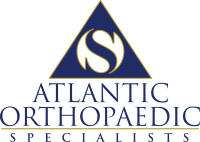What is the rotator cuff?
The rotator cuff muscles attach to the humeral head, which is the ball of the shoulder joint. These muscles provide strength for lifting the arm and rotating the shoulder. They also provide stability to the shoulder by holding the ball in the socket. The four muscles of the rotator cuff are the subscapularis, supraspinatus, infraspinatus and teres minor.
What is a rotator cuff tear?
A rotator cuff tear occurs when a portion of these tendons are torn off of the humeral head.
How do rotator cuff tears occur?
Most rotator cuff tears occur as a gradual process of wearing out. This is similar to how your jean pants or car tires would develop a tear if used for a long time. In fact, 60% of people over the age of 60 years old have a rotator cuff tear, which demonstrates that for many people this is just part of aging.
Other rotator cuff tears occur as a result of an injury. These are called “traumatic rotator cuff tears”. These can be caused by injuries such as a fall or a motor vehicle collision. Patients who have had a traumatic rotator cuff tear usually describe that their shoulder felt entirely normal before the specific injury occurred.
Do all rotator cuff tears need to fixed surgically?
No! The majority of rotator cuff tears can be effectively treated non-operatively using a combination of physical therapy, anti-inflammatory medications and cortisone injections. Research studies have shown that 75% of patients who have a rotator cuff tear are successfully treated without surgery.
What type of physical therapy is used for rotator cuff tears?
There are two main components to the physical therapy. First, the shoulder is stretched to eliminate stiffness, break up scar tissue and allow the shoulder to move easily.
The second phase of therapy is to strengthen the shoulder. There are many muscles that provide strength to the shoulder. By exercising these other muscles we can compensate for a rotator cuff tear. This is an exercise program that is helpful for rotator cuff tears.
It is important to note that in order for therapy to be successful the patient has to work at the exercises on a daily basis.
What medications do you recommend for rotator cuff tears?
Anti-inflammatory medications such as Ibuprofen, Naproxen, etc. can be helpful for the discomfort associated with rotator cuff pain. Tylenol can also be used. We do not recommend the use of narcotic pain medications for this problem. If an individual is having severe pain that requires narcotics other treatments may be considered.
When is surgery considered for treatment?
If a patient has not improved after 12 weeks of non-operative treatment then a rotator cuff repair surgery might be considered.

How is a rotator cuff repair performed?
Most often this surgery is done arthroscopically. This is a minimally invasive technique. Several small incisions are made to place a camera and instruments into the shoulder. The rotator cuff tendons are then re-attached to the humeral head.
What is the recovery process following surgery?
Recuperation after a rotator cuff repair is lengthy, however the surgery typically provides very good results. In general, the first six weeks after surgery the patient is wearing a shoulder sling at all times and performing very light shoulder stretches. Between six weeks to twelve weeks after surgery the patients is still wearing a sling but is doing regular physical therapy to regain a full range of shoulder motion by stretching. After three months the patient is no longer wearing a sling and may begin strengthening the shoulder. Most patients are feeling very good by six months and will continue to improve for up to a year to eighteen months.



